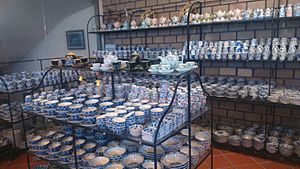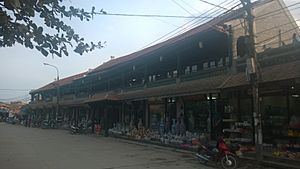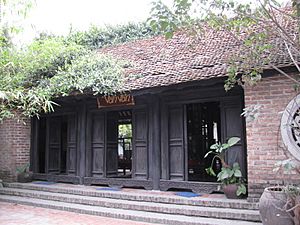Bat Trang Pottery Village facts for kids
Bat Trang is a very old village in Vietnam. It's super famous for making beautiful pottery and ceramics. Lots of tourists love to visit this village in North Vietnam. Bat Trang makes and sells many different kinds of ceramic items all over the country and even to other countries!
Contents
How Bat Trang Pottery Began
Bat Trang village started about 1000 years ago. It's in a part of Vietnam called the Red River Delta. This area had lots of white clay, which is perfect for making pottery.
Five skilled pottery families from a village called Bo Bat (now in Ninh Bình Province) moved to Bat Trang. They brought their pottery-making skills with them. These five families, along with the Nguyen family from Bat Trang, set up the first pottery ovens, called kilns, in the village.
Around the 12th century, a person named Hua Vinh Kieu learned new ways to make pottery from China. He taught the people of Bat Trang how to make a shiny white glaze for their ceramics.
What Kind of Pottery Does Bat Trang Make?
Bat Trang village has been making pottery since the 11th century. During the 11th and 12th centuries, the Ly Emperors of Vietnam chose Bat Trang pottery as special gifts for the Chinese Emperor.
The village has about 80 percent of the 1200 kilns that have been used since it began. Over the years, the types of products made in Bat Trang have become much more varied. Bat Trang pottery is well-known and popular in many countries around the world.
Bat Trang products are sorted into three main groups based on how they are used:
- Things for your home: These include plates, bowls, teacups, kettles, wine bottles, flowerpots, vases, and jars.
- Items for religious use: This group has things like lamp stands, candle holders, incense burners, and altar boxes.
- Decorations: These are items like statues and special pieces for buildings.
How Bat Trang Makes Money
Since the village started, most people living there have worked in the pottery business. Today, the village's economy relies on tourism and selling pottery. Besides earning money, the people also want to teach their craft. They want to keep these old skills alive for future generations.
Bat Trang ceramic village is very popular with tourists. Visitors can learn about the history, culture, and value of each handicraft product.
Fun Things to See and Do in Bat Trang
Bat Trang Village Festival
The Bat Trang village festival happens every year. It runs from the 14th to the 16th day of the second lunar month. This festival has many special activities to honor the first pottery makers.
Villagers play traditional games like xiangqi (Chinese chess), tug of war, and enjoy choir performances. Many beautiful ceramic products made by the village's best artists are shown during this time.
Bat Trang Pottery Market
The largest Bat Trang pottery market shows and sells many ceramic products from the village. Visitors can buy items and even learn how to make pottery themselves.
The market is located at the entrance to Bat Trang village. It covers a large area, about 20,000 square feet (6000 meters).
Van Van Museum
Van Van is a private museum that displays traditional pottery from Bat Trang village. Mr. Tran Ngoc Lam, who is part of the UNESCO Center for Research and Conservation of Vietnam Antiques, built this museum in 2002.
The museum includes three old houses from the 19th century. It shows more than 400 pottery items. These pieces were made by Bat Trang villagers from the 15th century all the way to the 19th century.
Where is Bat Trang?
Bat Trang is a small village in the northern part of Vietnam. It is part of the Gia Lâm district, which is near the capital city of Ha Noi. Bat Trang is located across the Chuong Duong bridge, about 8 miles (13 kilometers) southeast of Ha Noi's city center.





